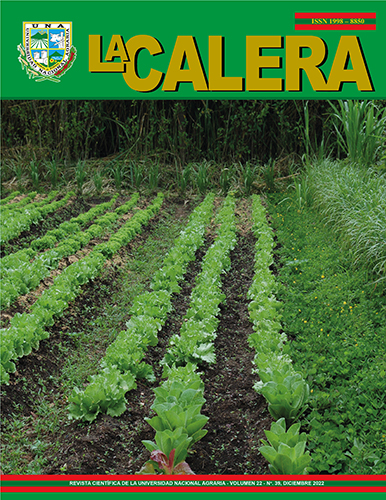Biomass production in protein banks of Quelite (Cnidoscolus aconitifolium (Mill)) and Marango (Moringa oleífera (Lam), farm Las Mercedes, Nicaragua
DOI:
https://doi.org/10.5377/calera.v22i39.14923Keywords:
Forage species, edible biomass, dry edible biomassAbstract
Climate change is contributing to the decrease in the production and crop yield of Nicaraguan farmers. The most damaging effect, due to variations in rainfall and temperature, affects food production directly, both for human and animal consumption. This study allowed the evaluation of total and edible biomass production, the survival rate and the identification of biological agents that affect the species Quelite (Cnidoscolus aconitifolium (Mill) LM), Marango (Moringa oleífera (Lam)), as an animal feed alternative under dry tropic conditions, at the Finca Las Mercedes Technological Experimentation and Validation Center, Managua. In order to evaluate the amount of produced biomass, each species was established in a 10.25m² plot and the collected data from two prunings over a period of a year. The species Quelite produced the highest amount of green biomass with 26 572 kg ha-1 in the first pruning and 62 666 kg ha-1 in the second pruning. This same species also produced the best edible dry biomass yields in the first and second pruning with 3 954 kg ha-1 and 11 505 kg ha-1 respectively, the Marango species had a green biomass production of 8 951 kg ha-1 in the first pruning, decreasing in the second pruning to 5 350 kg ha-1. The highest percentages of survival in the first pruning were obtained by the Quelite species with 100 %. Five months later this same species presented yields of 98 %, being classified as very good. Marango presented survival rates of 95 % and 79 %. The biological agents found did not cause damage to the Quelite plants but in Marango they were severe and affected the biomass production and survival of the plants.
Downloads
351
PDF (Español (España)) 86
EPUB (Español (España)) 109
Published
How to Cite
Issue
Section
License
Copyright (c) 2022 Universidad Nacional Agraria

This work is licensed under a Creative Commons Attribution-NonCommercial-ShareAlike 4.0 International License.

